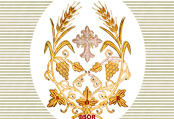|
|
|
- Who are the Syriac Orthodox?
The Syriac Orthodox are the faithful of one of the oldest apostolic
Churches, the Syriac Orthodox Church of Antioch. The Church is a universal
one in the sense that its faithful are from a diversity of backgrounds
(mainly Middle Eastern and Indian). It grew in the ancient land of
Syria (hence the name) which covers modern Syria, Iraq, Turkey, Lebanon,
Jordan and Palestine, but spread all over the East as far as India.
(See the Overview for more information.)
- Where are the headquarters of the Church?
The seat of the patriarchate moved from Antioch ca. AD 518,
after a period of turbulent history, to various locations in the Near
East until it settled in Deyrul-Zafaran
monastery in Mardin, Turkey, during the 13th century.
After another period of heinous violence during and after World War
I, which took the lives of a quarter million faithful, the patriarchate
was transferred to Homs, Syria, in 1933, and later to Damascus in
1957. (Go to the Patriarchate
for more information.)
- What is the language of the Church?
The official language of the church is Syriac, a dialect of Aramaic
- the language spoken by Lord Jesus Christ and His disciples. All
of its liturgy originates from Syriac sources. The church, however,
allows the faithful to use local languages along with Syriac. Many
liturgical works have been translated into Arabic, Malayalam, English
and Turkish.
- How does the Syriac Orthodox faith differ from other Christian faiths?
The Council of Chalcedon in A.D. 451 resulted in the schism of Christendom
into two groups. The Catholic (Rome) and Greek (Byzantine) Churches
accepted the Council, while the Syrian (Antioch) and Coptic (Alexandria)
Churches rejected it. The former group adopted the doctrine that Christ
is in two natures, human and divine, while the latter adopted
the doctrine that Christ has one incarnate nature from two
natures. It is worth noting that the drafts of the Council were according
to the position of the Syrian and Coptic Churches. The final resolution,
however, was according to the doctrine of the Western Churches. The
difference lies in one preposition as explained. One word split the
Church for centuries and the schism continues to this day.
- Is the Syriac Orthodox Church a monophysite church?
No. The monophysite dogma is an extreme version of the one
nature Christological doctrine put forth by Eutyches. It claims that
Christ has one nature only and that the divine nature subsumed the
human nature. Adversaries have accused the Syriac Orthodox Church
of the monophysite position. However this dogma has always
been rejected by the Syriac Orthodox Church. It is unfortunate that
this term is still used by some scholars. Prof. Sebastian Brock of
Oxford University has correctly suggested using the term miaphysite
which more accurately describes the Syriac Orthodox position.
- Is the Syriac Orthodox Church also called the Jacobite Church?
No. This is a name used by the adversaries of the church who attempt
to belittle the church by suggesting that the church was founded by
St. Jacob Baradaeus. During the sixth century, the Syriac Orthodox
Church endured persecution under the Byzantian Empire because it upheld
its faith. It was at this time that Jacob Baradeus emerged on the
scene. He journeyed all over the East ordaining priests and deacons
thus reviving the church from the brink of extinction. Jacob is considered
a great Saint of the Syriac Orthodox Church, but not its founder.
Hence, the Church rejects the name Jacobite. It should however be
noted that Syriac Orthodox Christians in Malankara (India) innocently
refer to themselves as Jacobites. For several centuries Christians
in Malankara were referred to by the term Nazarani. The term
Jacobite was introduced into Malankara in the nineteenth century by
Anglicans. Christians who remained in the mother church following
schisms influenced by the Anglicans adopted the term without realizing
its negative connotations.
- Is the Syriac Orthodox Church the only church that traces its origins
to the Church of Antioch?
No. There are other Patriarchates of Antioch. Following the Council
of Chalcedon in 451, the Seat of the Patriarchate was intermittently
occupied by adherents of two groups: the one which rejected and the
other which accepted the council. By the sixth century, two distinct
lines of patriarchs emerged. The Syriac Orthodox line rejected the
Greek Orthodox (called Rum Orthodox in the Middle East) who accepted
the council.
Around the seventh century, after another dispute in the Syriac Orthodox
church, followers of St. Maron in Lebanon formed the Maronite Church
whose patriarch also took the title, Patriarch of Antioch. This church
later became a uniate Roman Catholic church. In the 18th
century, a group split from the Rum Orthodox, joined the Roman Catholic
Church and formed the Greek Catholic Church (Rum Catholics). Their
patriarch also took the title, Patriarch of Antioch. In the second
quarter of the same century, a group split from the Syriac Orthodox
Church and established the Syrian Catholic Church, which is in communion
with Rome.
- What is the relation between the Syriac Orthodox Church in Antioch
and the Syriac Orthodox Church in India?
The Church in Malankara (Kerala, India) is an integral part of the
Syriac Orthodox Church. Apostle Thomas is believed to have set out
from Edessa, the cradle of Syriac Christianity, to India to preach
the Gospel in India. He is believed to have arrived in India in AD
52 and was martyred at Mylapore in Chennai (formerly Madras) in AD
72. Christianity in India since its earliest days adhered exclusively
to the Syriac tradition until the Portugese introduced the Latin tradition
in the 16th century. The spiritual head of the Malankara Syrian Orthodox
Church is the Syriac Orthodox Patriarch of Antioch. However, the Church
enjoys a considerable degree of autonomy, particularly in its temporal
affairs. Its local head is the Catholicos of the East, a position
that is currently vacant.
|
|
|

